Hummingbirds are enchanting, nimble creatures that captivate us with their extraordinary abilities and vibrant beauty. Tiny but mighty, hummingbirds are not only known for their rapid wing-flapping and hovering flight but also for their unique relationship with flowers. These high-energy birds rely on nectar as their primary source of sustenance, and they are irresistibly drawn to certain flowers that provide them with this essential fuel. Through their incredible adaptations, hummingbirds have developed a preference for specific flower types and colors that suit their unique feeding habits. This article will explore if hummingbirds like lavender, what attracts them to particular flowers, how they feed, and more.
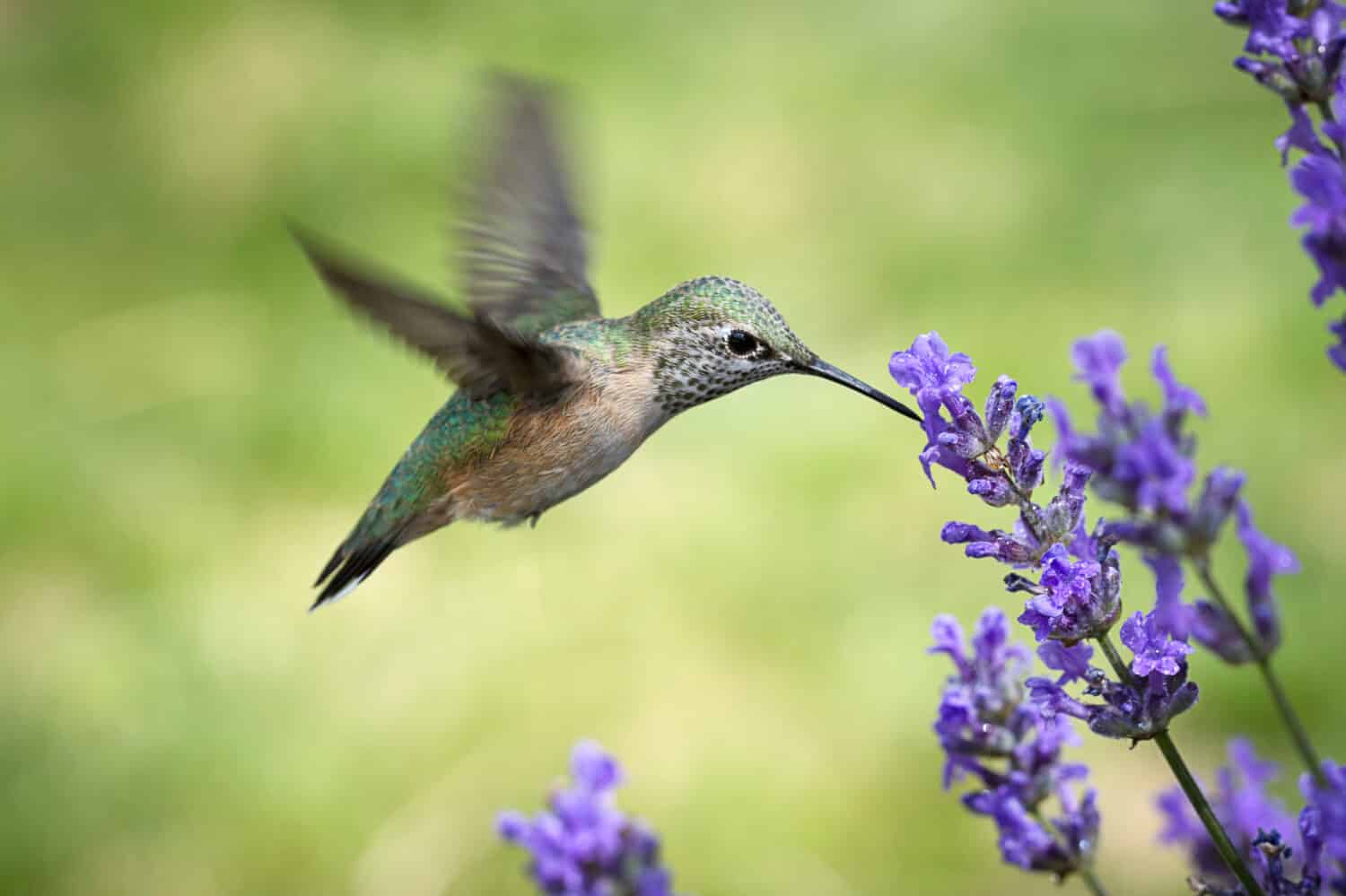
Though not their first choice, hummingbirds will feed from lavender.
©Gregory Johnston/Shutterstock.com
Do Hummingbirds Like Lavender?
Lavender is not a preferred flower for hummingbirds. Or at least it is not a top choice for them. The primary reason lies in the specific characteristics of lavender flowers and how they may not align perfectly with the hummingbirds’ natural foraging behavior and physiological needs. However, in certain circumstances, hummingbirds visit a wide range of flowers for nectar to ensure they meet their dietary needs.
Pros of Lavender for Hummingbirds
Lavender flowers typically have long, tubular shapes, which could suggest that they might be suitable for hummingbirds. After all, hummingbirds are well-known for their preference for tubular flowers, which allow them to use their long bills and tongues to extract nectar efficiently. Despite this similarity, lavender flowers do not always meet all the criteria hummingbirds look for in their preferred food sources.
Cons of Lavender for Hummingbirds
One possible reason for lavender not being a top choice for hummingbirds is that may deter hummingbirds from visiting lavender is the flower’s color. While hummingbirds are attracted to specific colors like red, orange, and bright pink due to their eyesight, lavender flowers typically display purple hues. These colors are not as preferred by hummingbirds, and they do not provide the same visual signals that the preferred colors do. As a result, lavender flowers may not stand out as prominently to hummingbirds, making them less likely to notice and visit these flowers in search of nectar.
Another factor is its nectar composition. Hummingbirds have a strong preference for nectar with substantial sugar content, often containing a high proportion of sucrose and averaging 26% sugar content. Lavender flowers, on the other hand, may produce nectar with lower sugar concentrations or have high proportions of fructose and glucose, making it less appealing to these energy-demanding birds. As a result, lavender flowers may not provide the same level of sustenance and fuel that hummingbirds desire to maintain their high metabolism and activity levels.
While lavender may not be a top choice for hummingbirds, these birds will still utilize these flowers while in search of nectar. Furthermore, during periods of food scarcity or when their preferred nectar sources are limited, hummingbirds may become more opportunistic and explore a broader range of flowers or insects, including lavender. In such times, they may visit lavender to supplement their regular nectar sources, albeit less frequently than they would visit their preferred flowers.
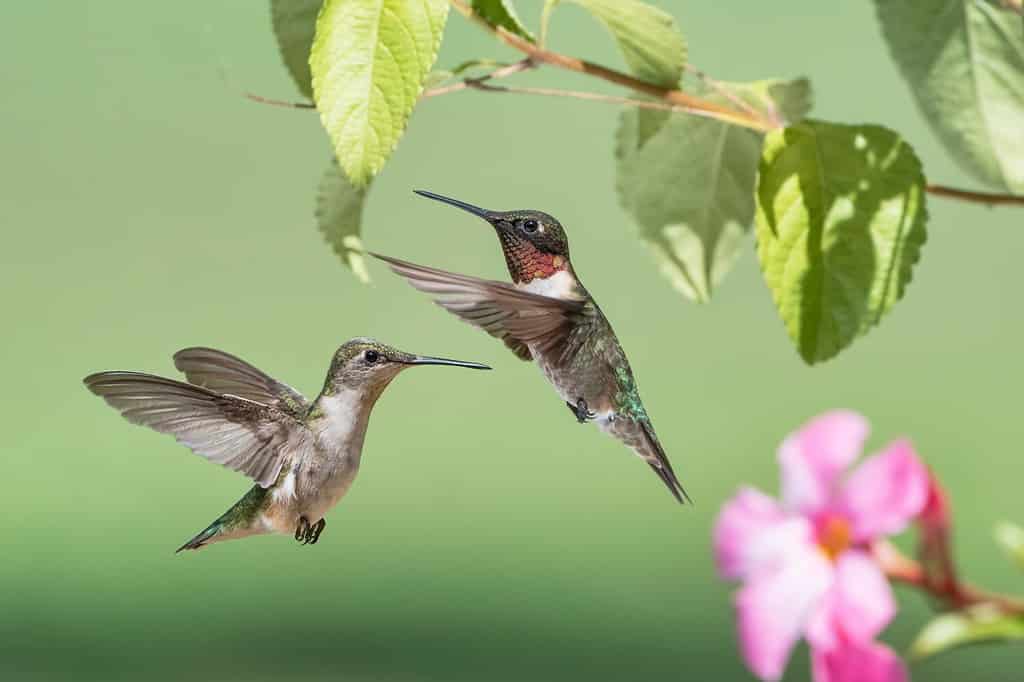
Hummingbirds are attracted to specific colored flowers, including hues of red and orange.
©Bonnie Taylor Barry/Shutterstock.com
How Do Hummingbirds Feed and Source Nectar From Flowers?
Hummingbirds are fascinating creatures with a high-energy lifestyle that demands a reliable food source. Their primary source of sustenance is flower nectar. However, they are also known to catch small insects, particularly during the breeding season or when nectar sources are low. To ensure they find enough food, hummingbirds have evolved various strategies for sourcing and collecting it.
Specific Colors and Shapes of Flowers Attract Hummingbirds
Hummingbirds are naturally drawn to specific colors and types of flowers. They tend to be attracted to flowers with orange or red petals or bracts, as these colors provide long-distance signals to the fast-flying birds, prompting them to take notice. Additionally, the flowers they are attracted to are often long and tubular, requiring the use of long, narrow bills and tongues to extract nectar effectively, which is perfectly suited for hummingbirds. These tubular flowers also hang down and point downward, making it easier for hovering hummingbirds to access the nectar.
The flowers that hummingbirds prefer usually provide a large amount of nectar with substantial sugar content, averaging about 26 percent. However, the nectar cannot be too concentrated and sticky. Hummingbirds rely on a long, tube-like tongue to gather nectar into their mouths. This occurs through wicking action, similar to water being drawn up a straw.
Hummingbirds have a strong co-evolutionary association with the plants they visit for nectar, resulting in a plant-bird mutualistic network. This relationship has led to specialized characteristics in both the birds and the flowers they pollinate. The hummingbirds’ beak lengths and shapes have evolved to match the flowers’ corresponding corolla length, curvature, and volume, enabling efficient nectar extraction. Some species of hummingbirds have highly specialized bill shapes adapted to a small number of flower species.
Flower Pollination and Nectar Production
For flowering plants to be evolutionarily successful, they usually need their pollen to be carried from one flower’s stamen to another flower’s pistil, leading to pollination. Hummingbirds play a crucial role in this process as they inadvertently carry pollen on their feathers and bills while feeding on nectar. Many plants have adapted to attract specific types of animals, like hummingbirds, for pollination by providing a nectar reward. That, consequently, keeps out potential nectar competitors. This selective mechanism ensures that the pollinating species seek out similar flowers for nectar, increasing the likelihood of successful pollination.
Hummingbird-pollinated flowers differ from insect-pollinated flowers in various ways. Hummingbird-pollinated flowers produce relatively weak nectar, containing a high proportion of sucrose and averaging 26% sugars. The flowers often produce a narrow color spectrum, which may make them rather inconspicuous to most insects, reducing nectar robbing. In contrast, insect-pollinated flowers usually have more concentrated nectar dominated by fructose and glucose.
Sourcing and Collecting Nectar From Flowers
Hummingbirds have exceptional adaptations for their high-energy lifestyles. They are specialized nectarivores. Thus, they feed on flower nectar as their primary source of energy. To meet their nutritional needs, hummingbirds also consume various insects, including mosquitoes, fruit flies, gnats, aphids, and spiders.
Hummingbirds have evolved specialized, long, slender tongues to extract nectar from flowers. When they reach nectar inside a flower, their tongues split open and fill with nectar. They then retract their tongues into a cylindrical configuration to complete the drink, effectively using their tongues as micropumps.
Because of their high metabolism, hummingbirds need to consume large amounts of nectar. On average, they consume around half their weight in nectar each day, and some species even consume twice their weight if the nectar is rich in sugar. This high energy demand makes them highly attuned to food sources. Using their enlarged hippocampus, they can remember the locations of flowers they have visited.
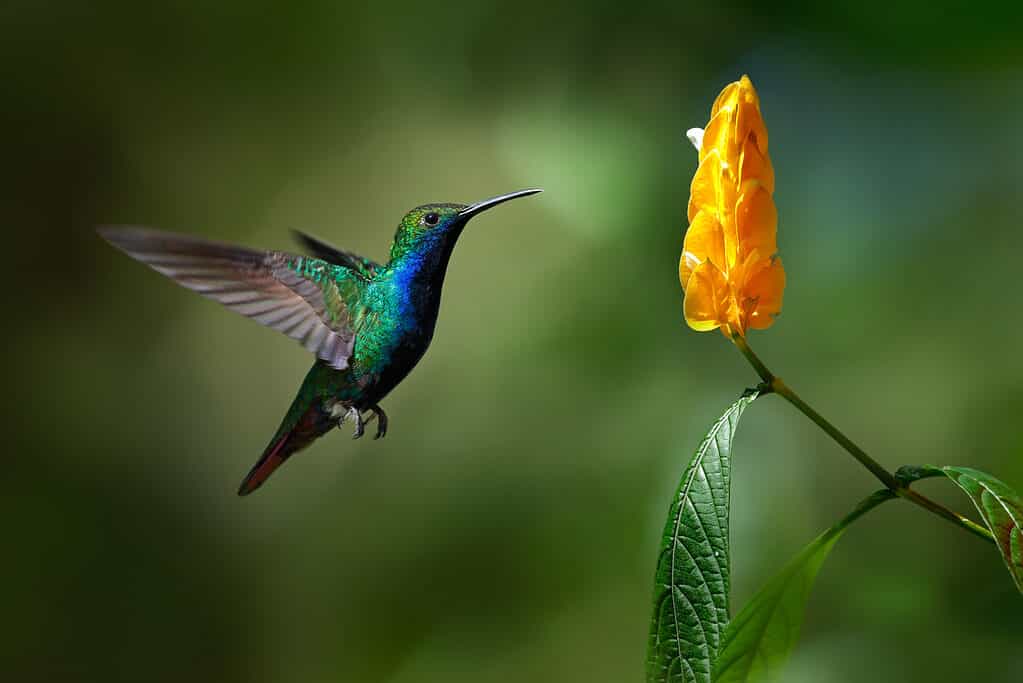
Hummingbirds are nectarivores. They primarily feed on nectar.
©Ondrej Prosicky/Shutterstock.com
Lavender Growing Tips
Growing lavender can be a rewarding experience, attracting pollinators such as bees, butterflies, and occasionally hummingbirds to your garden or landscaping. Lavender is a versatile and beautiful plant that offers aromatic and visual delights. Here are some tips for successfully growing lavender and making it thrive in your outdoor space.
Sunlight, Soil, and Fertilization
Lavender thrives in full-sun environments. Ensure it gets at least 6 to 8 hours of direct sunlight daily. Place your lavender plants in a sunny spot in your garden or landscaping to promote healthy growth and abundant flowering.
As for soil, it prefers well-draining soil to prevent waterlogging, which can lead to root rot. Sandy or loamy soil with good drainage is ideal for lavender plants. Avoid heavy clay soils that retain too much moisture. It also grows best in low to moderately-fertile soils. It doesn’t require heavy fertilization. Too much nitrogen can lead to excessive leaf growth at the expense of flower production. Use a balanced, low-nitrogen fertilizer sparingly in the spring.
Watering and Air Circulation
Lavender is drought-tolerant once established, so avoid overwatering. Allow the soil to dry out between watering sessions. Water deeply but infrequently to encourage the roots to grow and become more resilient to drought. A general rule of thumb is to water 1 to 2 times weekly for the first growing season. Lessen watering to once every 2 to 3 weeks until flower buds form, and increase watering to as frequent as once per week once flowers bloom. And reduce watering again to 2 to 3 times weekly after harvesting the flowers. Watering will vary depending on your region and where lavender is planted, such as in a garden, a pot, or landscaping.
Finally, good air circulation around lavender plants helps prevent diseases and encourages healthy growth. Avoid planting lavender too close together or in areas with poor air circulation, or proximity to direct forced heating or cooling.
Pruning and Propagation
Regular pruning is essential to keep lavender plants compact and encourage new growth. Prune back the plants after they finish flowering, usually in late summer. Trim off spent flower spikes and shape the plant to maintain its form. Without pruning, lavender can become shapeless and woody, with long bare stems and few flowers.
You can propagate lavender through cuttings. Take semi-ripe cuttings from healthy plants in late spring or early summer and root them in well-draining soil or water.
Pest Control
Lavender is relatively resistant to pests and diseases, but keep an eye out for common garden pests like aphids and spider mites. Use natural pest control methods if necessary, such as releasing ladybugs or using neem oil.
Lavender is native to the Old World, which includes Cape Verde, the Canary Islands, Europe, northern and eastern Africa, the Mediterranean, southwest Asia, and India. It thrives in warm, sunny climates with well-draining soil. It grows best in USDA zones 5 to 9 in the United States. If you live in a colder zone, consider planting cold-hardy lavender varieties. Popular lavender species for gardening and landscaping include English lavender (Lavandula angustifolia), French lavender (Lavandula dentata), and Spanish lavender (Lavandula stoechas).
With its aromatic fragrance, beautiful flowers, and ability to attract pollinators, lavender is an excellent addition to any garden or landscaping. Whether you have a large garden or limited space, growing lavender can bring beauty, color, and a touch of serenity to your outdoor oasis.
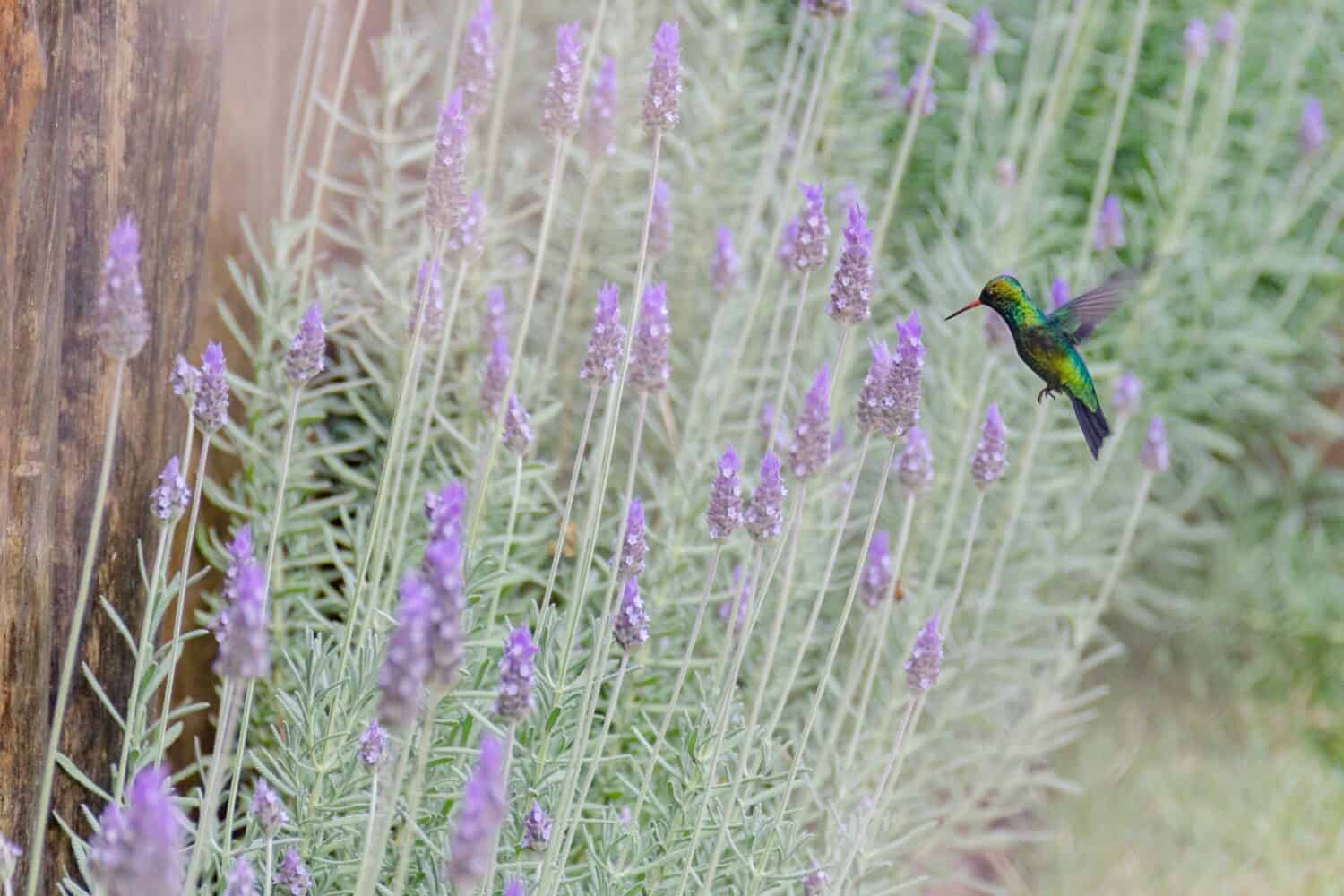
Hummingbirds prefer nectar that has a 26% sugar content, with a high proportion being sucrose.
©Zaratini/Shutterstock.com
6 Other Flowers Hummingbirds Are Attracted To
Hummingbirds are irresistibly drawn to a variety of flowers due to their vibrant red and orange colors. In addition to the tubular shape of their blossoms. Bee balm, cardinal flower, trumpet creeper, honeysuckle, columbine, and catmint are among the top flowers hummingbirds find rewarding sources of nectar. These blossoms provide essential fuel for hummingbirds. They are ideally suited for these birds to avoid too many other nectar competitors. This creates an indispensable partnership between specific flowers and hummingbirds in the pollination process. Furthermore, these flowers add beauty and charm to gardens and landscapes.
Bee Balm (Monarda spp.)
Bee balm, also known as bergamot, is a favorite among hummingbirds due to its vibrant colors and abundant nectar. The tubular shape of bee balm flowers makes it easy for hummingbirds to access the sweet nectar hidden within. The bright red, pink, white, or purple hues of bee balm act as long-distance beacons. They catch the attention of these agile birds as they search for nectar. Additionally, bee balm’s tendency to bloom in large clusters provides an ample food source. It attracts hummingbirds and other pollinators like bees and butterflies. Furthermore, bee balm has a long flowering period. It offers a reliable food source for hummingbirds throughout the spring and into late summer.
Cardinal Flower (Lobelia cardinalis)
The cardinal flower’s common intense red color is a magnet for hummingbirds. These birds can spot it from afar and home in on the nectar-rich prize. The unique tubular shape of the cardinal flower’s blossoms perfectly facilitates efficient nectar extraction for hummingbirds. These vibrant red flowers stand out prominently against green foliage. This makes them easily visible to hummingbirds as they dart through the landscape in search of sustenance. They also come in colors such as burgundy, pink, or white. Cardinal flowers are native to North America and thrive in wetland habitats and low woods.
Trumpet Creeper (Campsis radicans)
As its name suggests, the trumpet creeper’s flowers resemble trumpets or funnels. They come in vibrant orange, red, or yellow hues. Hummingbirds are particularly attracted to trumpet creepers because of the deep, tubular shape of the flowers. These flowers perfectly accommodate their specialized feeding techniques. The trumpet creeper’s large clusters of blossoms provide an abundant and convenient nectar source for hummingbirds as they fly from flower to flower. This vigorous vine is a favorite for hummingbirds throughout the United States. It has a strong appeal to gardeners looking to attract these delightful creatures.
Honeysuckle (Lonicera spp.)
Honeysuckle is a well-known favorite of hummingbirds, offering a delightful fragrance and abundant nectar. The tubular shape of honeysuckle flowers perfectly suits the hummingbird’s feeding habits. They come in shades of orange, pink, red, yellow, or white. The sweet optimal nectar within these flowers is a highly sought-after energy source for hummingbirds. They will often return to honeysuckle patches repeatedly for their daily sustenance. Honeysuckle vines climbing on trellises or fences provide a stunning display of flowers. As well as a hummingbird-friendly environment in gardens across various regions.
Columbine (Aquilegia spp.)
Columbine flowers have a distinct and intricate design that appeals to both hummingbirds and gardeners alike. The unique shape of columbine blossoms, with their tubular spurs extending from the petals, provides a visual cue to hummingbirds that abundant nectar can be found. The flowers come in various colors, including pink, red, blue, purple, white, yellow, and bi-colors. Many of which can attract hummingbirds from a distance.
Catmint (Nepeta spp.)
Catmint, also known as catnip, is a surprising addition to the list of flowers that attract hummingbirds. While it is famous for its appeal to cats, catmint has tubular flowers that hummingbirds find enticing, similar to lavender. The lavender, blue, pink, or white blossoms of catmint stand out against its aromatic foliage. Catmint is a hardy and low-maintenance perennial. It is a popular choice for gardeners looking to attract hummingbirds and perhaps even feline friends to their outdoor spaces.
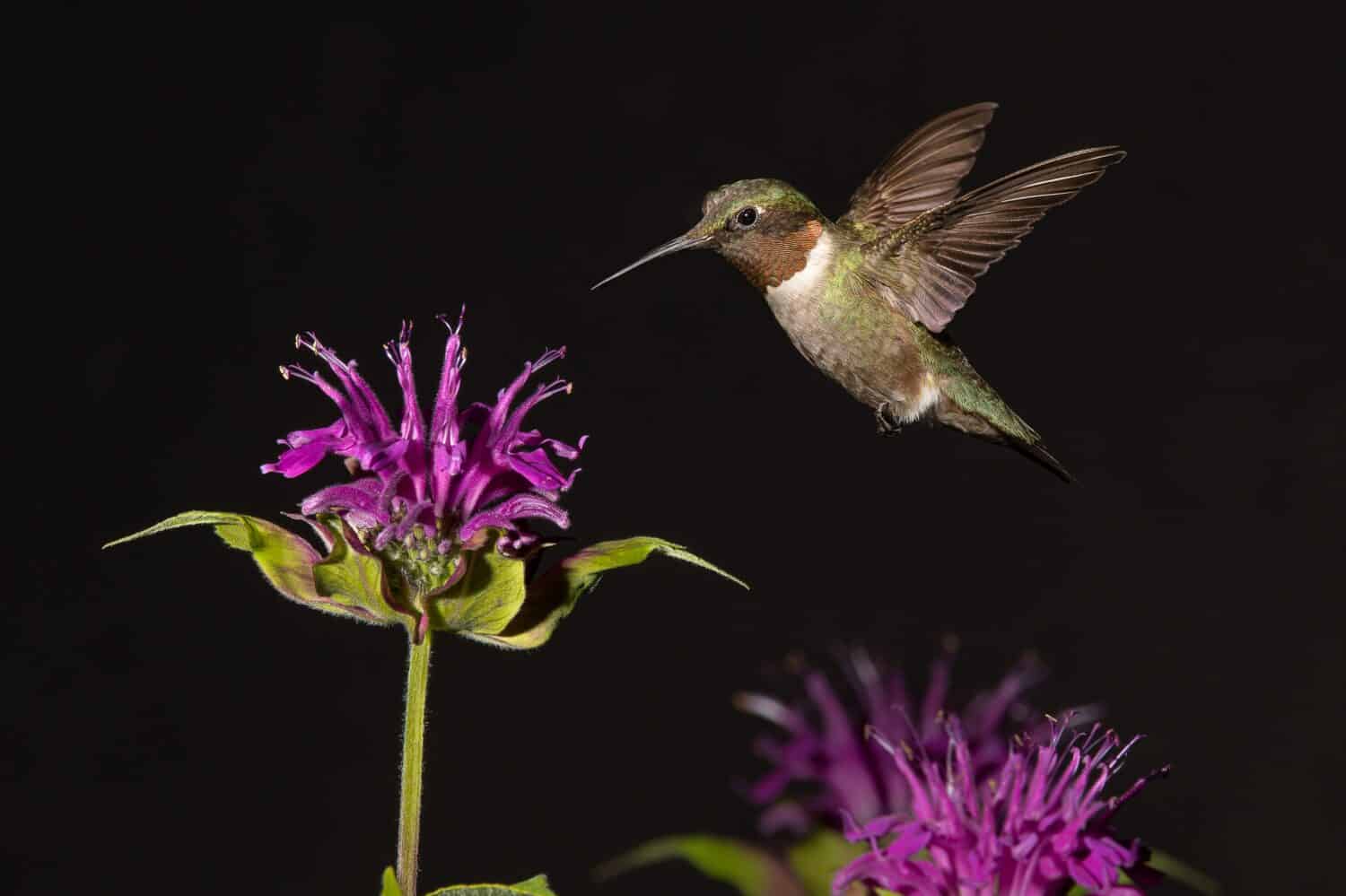
Hummingbirds are highly attracted to bee balm as it is perfectly suited for their nectar preferences.
©Matt Cuda/Shutterstock.com
Conclusion
In conclusion, hummingbirds are captivating creatures that are attracted to certain flowers for their rich nectar and vibrant colors. They require reliable food sources to sustain their high-energy output. Moreover, they seek out tubular-shaped flowers that accommodate their long tongues for efficient nectar extraction specific to their physiology. Flowers like bee balm, cardinal flower, trumpet creeper, honeysuckle, columbine, and catmint are among their favorites. These flowers provide them with the sustenance they need to maintain their rapid flight and active foraging habits. While lavender may not be their top choice, hummingbirds still visit lavender flowers as a secondary nectar source. Overall, these delightful birds play a crucial role in pollination. They bring beauty and life to gardens and landscapes across the world.
Thank you for reading! Have some feedback for us? Contact the AZ Animals editorial team.







